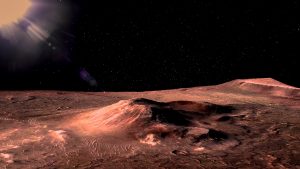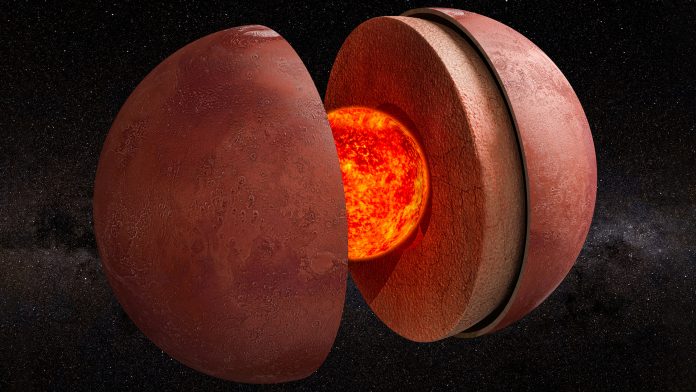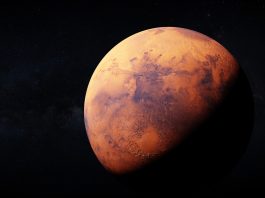The presence of an enormous, active mantle plume, thought to be the cause of intense volcanic and seismic activity on Mars, has been unveiled by orbital observations from University of Arizona researchers.
Many have thought that Mars has been a dead planet for at least three billion years due to the apparent absence of shifting tectonic plates on the planet’s surface. However, scientists from the University of Arizona are challenging Mars’ geodynamic evolution with a report on the discovery of an active mantle plume pushing the surface upward, causing earthquakes and volcanic eruptions.
The study, ‘Geophysical evidence for an active mantle plume underneath Elysium Planitia on Mars,’ published in Nature Astronomy, suggests that the planet may have a more tumultuous interior than previously thought.
An active mantle plume on Mars
“Our study presents multiple lines of evidence that reveal the presence of a giant active mantle plume on present-day Mars,” said Adrien Broquet, a postdoctoral research associate in the UArizona Lunar and Planetary Laboratory and co-author of the study with Jeff Andrews-Hanna, an associate professor of planetary science at the LPL.
Mantle plumes are blobs of warm and buoyant rock that rise from deep inside a planet, pushing their way through the mantle in order to reach the base of its crust, resulting in earthquakes, faulting, and volcanic eruptions. For example, the island chain of Hawaii was formed as the Pacific plate slowly moved over a mantle plume.
“We have strong evidence for mantle plumes being active on Earth and Venus, but this isn’t expected on a small and supposedly cold world like Mars,” Andrews-Hanna said. “Mars was most active three to four billion years ago, and the prevailing view is that the planet is essentially dead today.”
“A tremendous amount of volcanic activity early in the planet’s history built the tallest volcanoes in the solar system and blanketed most of the northern hemisphere in volcanic deposits,” Broquet said. “What little activity has occurred in recent history is typically attributed to passive processes on a cooling planet.”
Studying Elysium Planitia
The researchers were drawn to a region on Mars called Elysium Planitia, a plain within Mars’ northern lowlands, close to the equator. This area, unlike other volcanic regions on Mars, has experienced a surprising amount of activity, with large eruptions occurring in the area over the past 200 million years.
“Previous work by our group found evidence in Elysium Planitia for the youngest volcanic eruption known on Mars,” Andrews-Hanna said. “It created a small explosion of volcanic ash around 53,000 years ago, which in geologic time is essentially yesterday.”
The volcanism in this area originates from the Cerberus Fossae, a set of young fissures that stretch for more than 800 miles across the Martian surface. NASA’s Insight team has recently discovered that most marsquakes come from this region. The underlying cause of this volcanic activity remains unknown, despite it being well-studied.
On Earth, volcanism and earthquakes are associated with mantle plumes or plate tectonics. “We know that Mars does not have plate tectonics, so we investigated whether the activity we see in the Cerberus Fossae region could be the result of a mantle plume,” Broquet said.
Mantle plumes reveal their presence on Earth through the material pushing the surface, subsequently stretching the crust. Molten rock then erupts as flood basalts, creating volcanic plains.
Through the study of Elysium Planitia, the team found evidence of the same sequence of events occurring on Mars. Mars’ surface has been uplifted by more than a mile, with analysis discovering that this uplift is supported from deep within the planet, consistent with the presence of a mantle plume.

The team also found that the floor of impact craters is titled in the direction of the plume, supporting the idea that something pushed the surface up after the craters formed. Finally, the researchers applied a tectonic model to the area, finding that the presence of a giant mantle plume, around 2,500 miles wide, was the only way to explain the extension responsible for forming the Cerberus Fossae.
“In terms of what you expect to see with an active mantle plume, Elysium Planitia is checking all the right boxes,” Broquet said, adding that the finding poses a challenge for models used by planetary scientists to study the thermal evolution of planets. “This mantle plume has affected an area of Mars roughly equivalent to that of the continental United States. Future studies will have to find a way to account for a very large mantle plume that wasn’t expected to be there.
“We used to think that InSight landed in one of the most geologically boring regions on Mars – a nice flat surface that should be roughly representative of the planet’s lowlands,” Broquet added. “Instead, our study demonstrates that InSight landed right on top of an active plume head.”
InSight must now take into account the fact that this region is far from normal for Mars, with the presence of an active plume affecting the seismic data recorded.
“Having an active mantle plume on Mars today is a paradigm shift for our understanding of the planet’s geologic evolution,” Broquet said, “similar to when analyses of seismic measurements recorded during the Apollo era demonstrated the Moon’s core to be molten.”
Implications for life on Mars
The authors explain that their findings could have implications for life on Mars. In its recent geologic past, the studied region had experienced floods of liquid water; but the cause of this has remained a mystery. The same heat from the mantle plume that is fuelling volcanic and seismic activity could also melt ice to make floods. Further to this, chemical reactions could be driven by this heat, enabling life deep underground to be sustained.
“Microbes on Earth flourish in environments like this, and that could be true on Mars, as well,” Andrews-Hanna said, adding that the discovery goes beyond explaining the enigmatic seismic activity and resurgence in volcanic activity.
“Knowing that there is an active giant mantle plume underneath the Martian surface raises important questions regarding how the planet has evolved over time. We’re convinced that the future has more surprises in store.”









